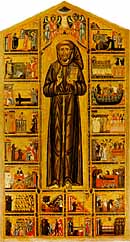
The Basilica and the Arno
Excusez nous mais cette page n'est pas été encore traduite en Français
The square and Basilica of Santa Croce, together with the vegetable gardens and Convent of the Franciscan Order, were built in a marshy area and stood outside the city walls until 1284-1333, when the Florentine Republic, in spite of being involved in the fight for power between the "Black" and "White" Guelphs, decided to construct the third ring of city walls (the fifth since the the Roman foundation of the city). This was also when several major works were carried out which included alterations to the courses of the rivers Mugnone (to the north) and the Arno (to the south), one of whose secondary tributaries left the first Franciscan oratory standing on a sort of little island in the Arno.
The first documents to mention this early settlement of the mendicant order date from around 1225-26 (though documents mention the presence of the occasional friar in the city from 1208 onwards) and, according to tradition, it was founded by Francis himself, when he passed through Florence in 1221 to meet St. Dominic (the event is celebrated in a lunette by Andrea della Robbia in the loggia of the Hospital of San Paolo in Piazza Santa Maria Novella). Moreover Fra Jacopo, the artist commissioned in around 1225-28 to carry out the mosaics in the "scarsella" or rectangular apse of the Baptistery (and therefore known as Fra Jacopo della Scarsella), was a member of this Franciscan community.

B.Berlingheri,
The story of St. Francis
The "Poor Man of Assisi" died in 1226. Two years later, in 1228, he had already been canonized by the Church and his monks' sermons had such an overwhelming success in Florence that by 1252 there was already talk of starting work on an initial enlargement of the little church. This trasformation was also to bring about the protests of the so-called "Spiritual Fathers", the more conservative members of the Order, led by Ubertino da Casale, who saw it as a sign of pride and contrary to St. Francis' teachings on humility and poverty. This controversy became even stronger forty years later, when the two Father Superiors of the Convent, Fra Caponsacchi and Fra Giovenale degli Agli, decided to build a brand new church, which was to be grandiose in size (it is the largest Franciscan basilica in Italy), and, what was more, asked the most fashionable architect of the time, Arnolfo di Cambio, to construct it for them.
